England is not known for its aggressive animals. Most of the big predators, such as wolves, were hunted to extinction in the 19th century or before. Dangerous bears, big cats, and sharks aren’t England natives, so what does that leave? Here are the ten most aggressive animals in England today. Some are pretty obvious, like snakes, but others might surprise you.
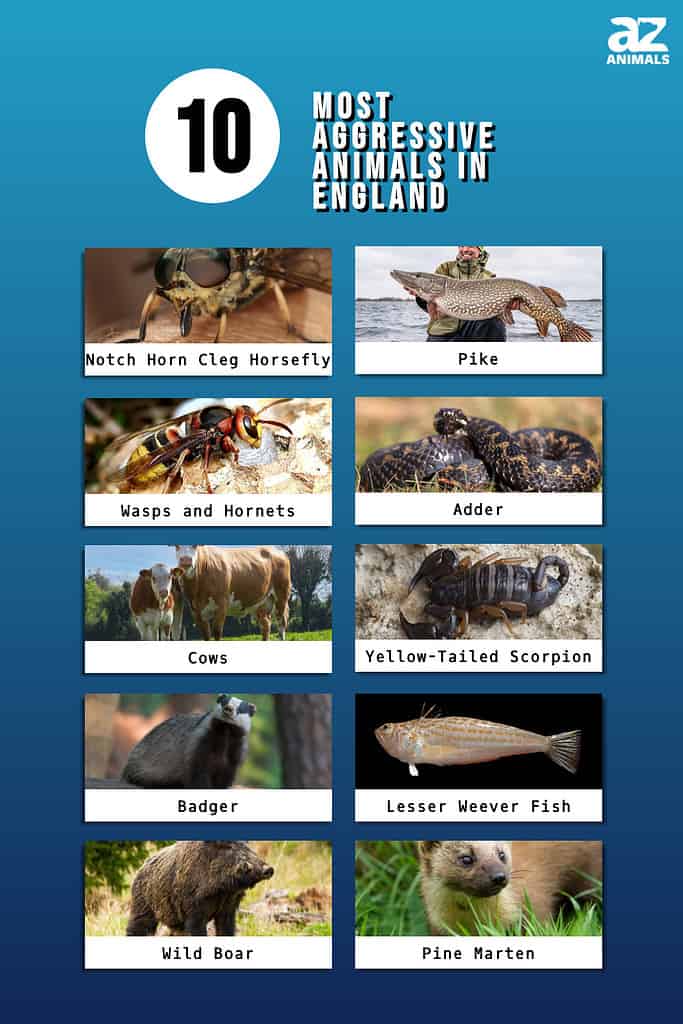
1. Notch Horn Cleg Horsefly
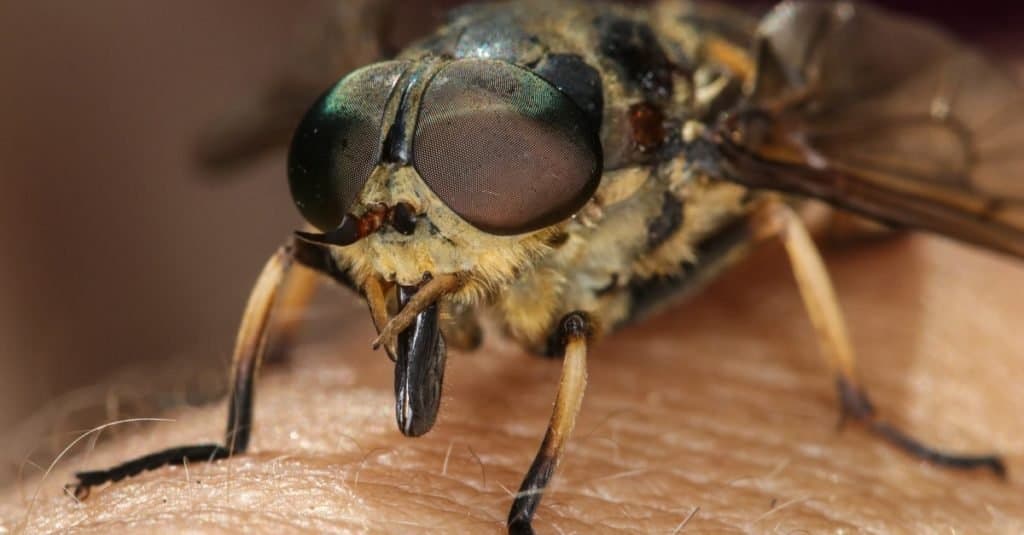
Horseflies use anticoagulants to keep blood flowing from their victims.
©Geza Farkas/Shutterstock.com
Horseflies feed on blood, usually from cattle, but horseflies bite humans too. Their chomp is infamously painful, and experts think it’s because horseflies tend to feed on animals that can’t swat them away, so they didn’t bother to evolve an anesthetic like mosquitoes.
A horsefly in England means business. It doesn’t hover around and feel frightened by a waved hand. It dives in and bites with its knife-like mouth parts slicing open skin. As it feeds, it adds anticoagulants to prevent blood clotting. If it’s brushed off, it dives back in.
These flying horrors reach 2.4 inches long in England, but notch horn horseflies only reach half an inch. In June and July, they torment cattle to distraction.
Horseflies appear dark gray with iridescent striped eyes. Thirty species prey on animals in England, but unlike the other horseflies, the Notch-horned cleg-fly species is a silent predator. Once it locates a victim by sight, very little will dissuade it from a meal.
Horseflies even have dangerous predatory larvae. Eggs laid in mud or near water hatch into predators that eat invertebrates.
A horsefly bite will likely require painkillers and antiseptic ointment to avoid infection. Horseflies spread parasites and disease, so cleaning up the wound is essential.
2. Pike
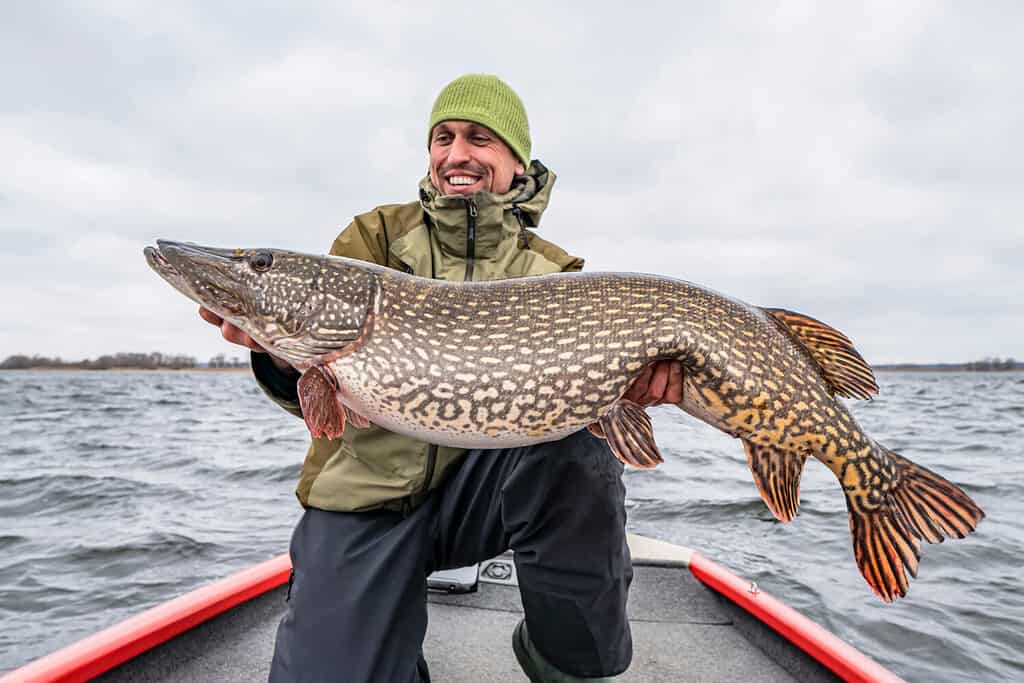
Pike fish grow so large they’re capable of taking adult ducks.
©FedBul/Shutterstock.com
Predatory pike are massive fish patrolling England’s waterways. A pike is long and slender with large eyes and a flattened head full of sharp teeth. Usually, they appear greeny-brown with cream patches. Aggressive pike hide in weeds before bursting out to grab their fish, frogs, crustaceans, or mammal prey.
The largest pike reach five feet long. These river and canal monsters take ducklings and moorhens, and there are even reports of pike attacking adult ducks. Because pikes can eat an animal half their size, many aquatic animals and birdlife are vulnerable.
Pike anglers say these fish are highly aggressive in the water and when landed. Their sharp teeth cause deep wounds.
3. Wasps and Hornets
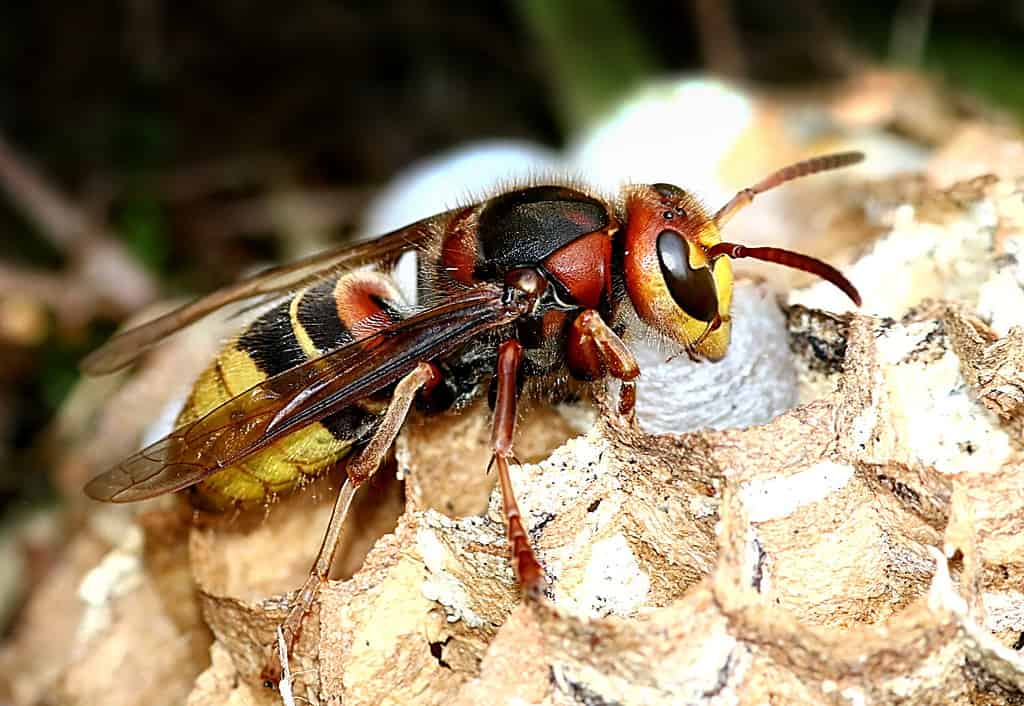
Hornet wasps are much larger than common wasps in England but less aggressive.
©Ger Bosma Photos/Shutterstock.com
Wasps and hornets become aggressive over the summer months, and they can kill people allergic to their venom. Bee and wasp sting anaphylactic shock claims up to 12 people a year in Britain.
Common wasps love sugary, high-energy food and enjoy taking advantage of human picnics. They appear in their striped yellow and black glory to terrorize the population in summer. Common wasps live in large groups and build papery nests in attics, sheds, hollow trees, and even hedgehog nesting boxes.
Wasps are not popular animals due to their aggressive tendency. Many folks stung by a wasp insist they did nothing to antagonize it first. Experts don’t know why aggression is a typical attitude found in common wasps.
Commoners reach up to half an inch, but a bigger wasp by far is a hornet. These wasp-chinooks reach an inch long, and you can hear their deep rumbling approach. However, hornets are not as aggressive as common wasps in England and tend to avoid humans.
4. Adder
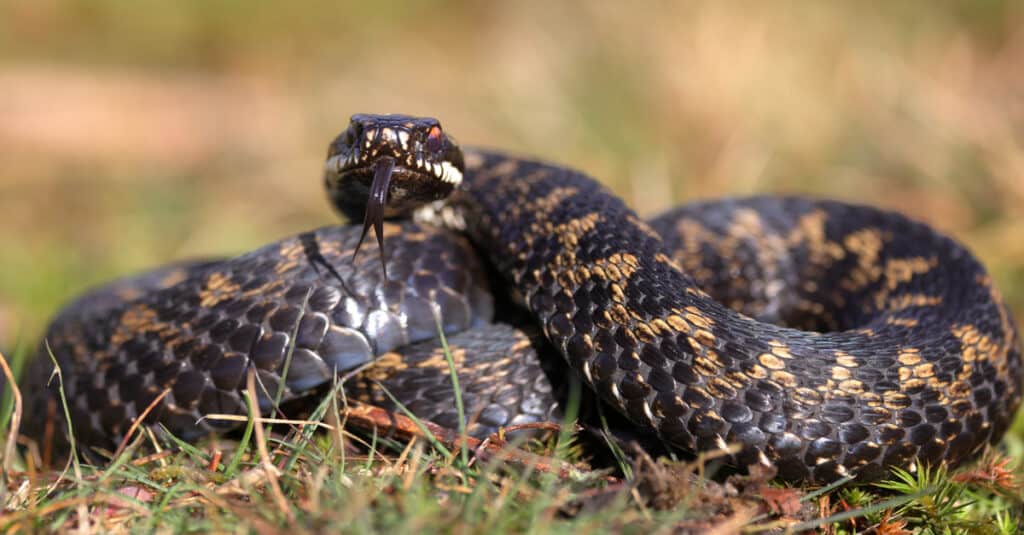
The last adder death in England occurred in 1975.
©Edwin Godinho/Shutterstock.com
The common European adder is the only venomous snake in England, and it’s pretty rare. Only 100 bites are documented annually, and no deaths have occurred from adder bites since 1975. Nevertheless, this snake is capable of killing; each year, its bite leads to amputation and dog deaths.
Adders prefer warm parts of England. They’re chiefly found in the south’s sandy dunes but also live in woodlands and heathland. Adults reach 2.5 feet long and hunt ground-nesting birds like skylarks, small mammals, and lizards. They hibernate from October, emerging in March when the temperature rises.
Easy to identify, adders appear gray with a spine-length black zigzag. Red eyes with vertical slits differentiate them from harmless grass snakes. Adders do not hunt out humans and only become aggressive when disturbed, trodden on, or threatened.
5. Cows
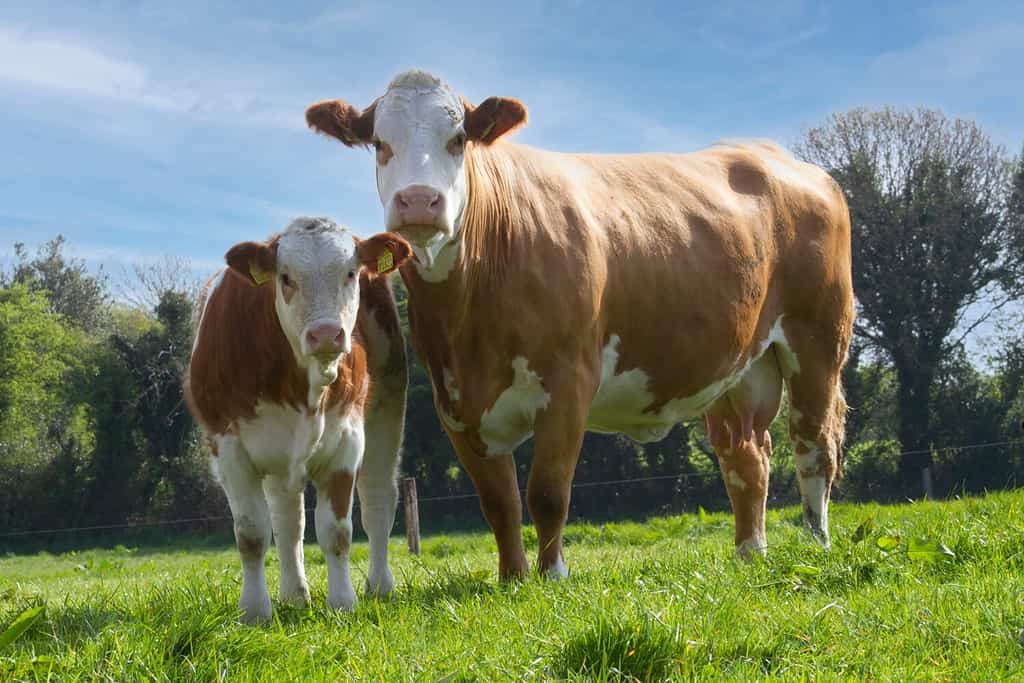
Cows are not naturally aggressive, but mothers defend their calves by kicking and stampeding.
©Show Business/Shutterstock.com
Cows kill several people in England each year. Although not naturally aggressive, docile cattle grazing in English fields have strong maternal instincts. If they feel their calf is threatened, they charge. Groups of cows may stampede if frightened or provoked. Cows trapped or scared by dogs lash out with strong legs and sharp hooves. This can lead to severe injury. In England, keeping dogs on leads is wise if you’re crossing farmland. 9.7 million cows are farmed in England, so it’s not surprising that occasionally aggressive cows lash out.
6. Yellow-Tailed Scorpion
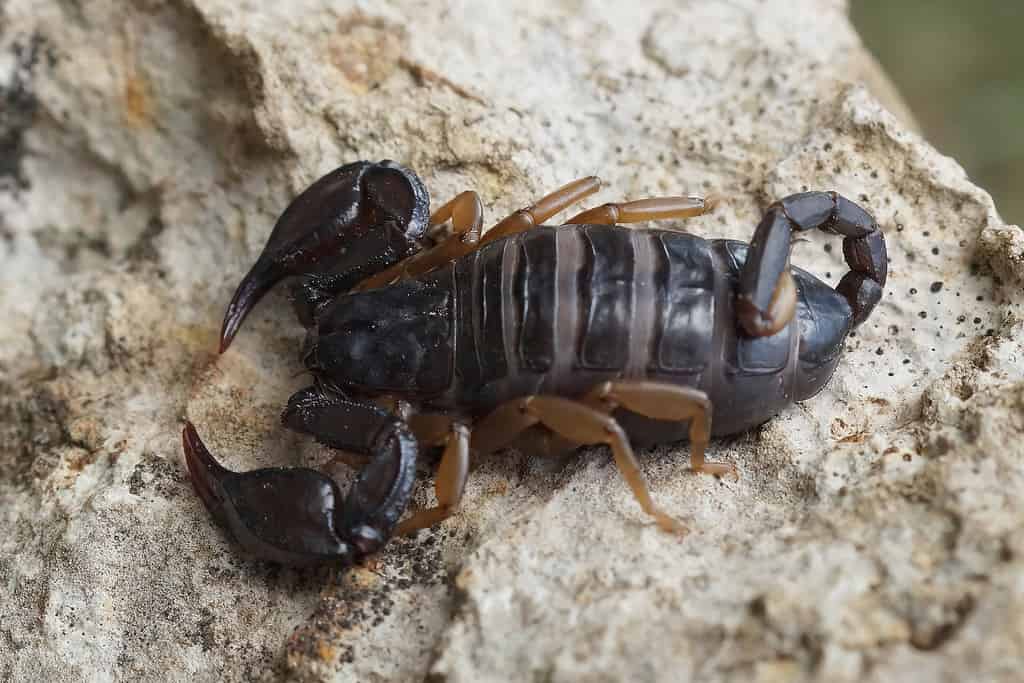
Tiny yellow-tailed scorpions made their way to England in a consignment of Mediterranean masonry.
©iStock.com/Wirestock
Scorpions in England? It sounds unlikely, but in the 19th century, a shipment of Mediterranean masonry accidentally introduced them.
They’ve found a foothold in Kent, Plymouth, and parts of London where they hide in crumbling masonry waiting for a tasty meal of spider or woodlouse to cross their path. Experts think they have not colonized the country because the weather is too cold and damp for these Mediterranean creatures.
This diminutive scorpion has a black body and tail with a yellow-tan tail. It hunts at night and doesn’t tend to use its stinging tail but grabs and devours prey with claws and teeth. Under UV light, it glows bright green-blue!
7. Badger
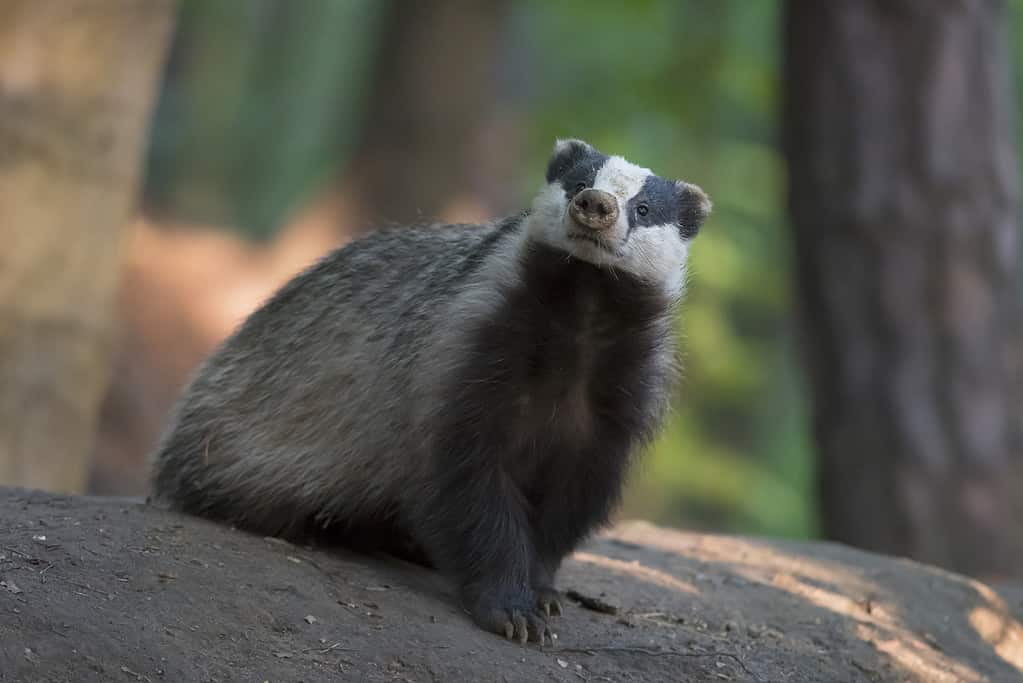
Omnivorous badgers are England’s largest land predator. They hunt
earthworms
, hedgehogs, and frogs.
©iStock.com/Maciej Jaroszewski
The storybook says the English badger is England’s largest land predator. Badgers eat roots and vegetation but hunt earthworms and hedgehogs at night. Humans rarely see them unless as roadkill. During daylight hours, badgers sleep in family groups in setts beneath the earth.
Badgers have cute black and white stripes, strong bodies, and formidable digging claws. Centuries ago, badger baiting with dogs for sport was popular, but it’s illegal in England now.
Whilst badgers are not aggressive towards humans, they bite and scratch with more force than an average dog. Couple that with their five feet length and 26.5 lbs body weight, and it’s not a good outcome for challengers.
8. Lesser Weever Fish

Lesser weever fish’s (
Echyichtes vipera) venom is highly painful, and unfortunately, swimmers and divers report aggressions to humans.
©Hans Hillewaert / CC BY-SA 4.0 – License
Lesser weever fish live across Europe and often venture onto the southern Dorset beaches, where they burrow into the sand and leave five small spines uncovered to deter anything that may squash them. Their venom is highly painful, and unfortunately, swimmers and divers report they show aggression to humans when swimming.
These venomous fish are chunky and silvery-white with a mottled pattern that disguises them in the sand sea bed. They can reach 12 inches long and have eyes on the top of their head. Lesser weaver fish hunt other small fish plus crustaceans, grabbing passers-by with their large, upturned mouths.
9. Wild Boar
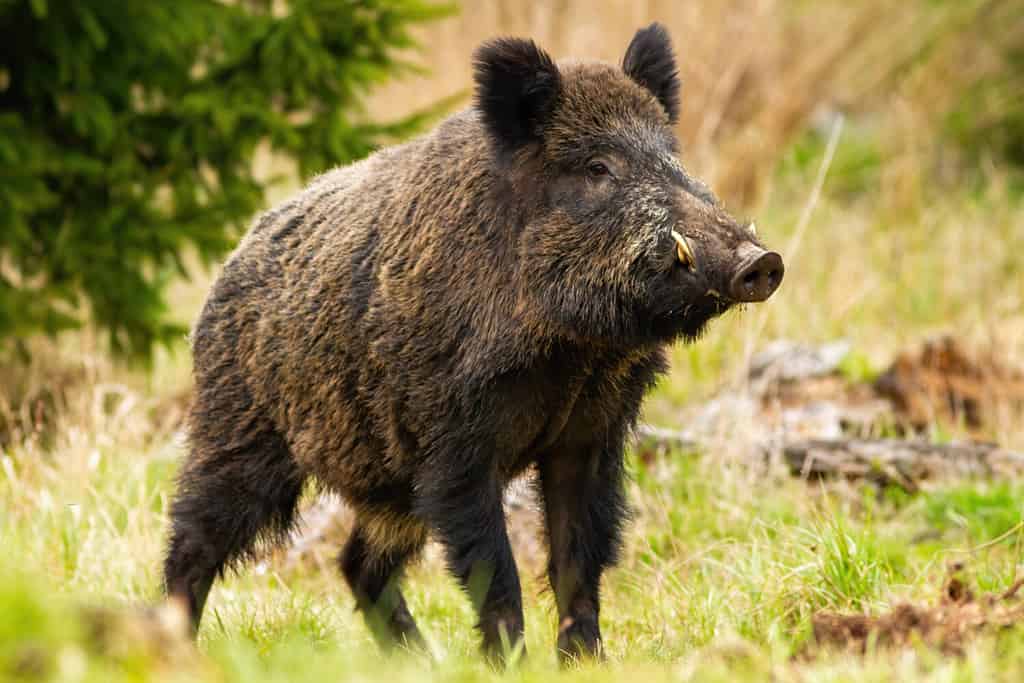
Wild boar were hunted to extinction in England’s Middle Ages, but a wild population escaped the meat trade and lives in the Forest of Dean.
©WildMedia/Shutterstock.com
Aggressive native wild boar were hunted to extinction in the Middle Ages. However, small pockets of wild boar exist in woodland. This population has escaped from captivity and is bred in the wild. Experts estimate around 2,500 inhabit the Forest of Dean and across southwest to southeast England.
Omnivorous boars eat green plants, nuts, fungi, bulbs, seeds, eggs, and carrion. They are powerful animals with bristly outer hair that conceals a warmer undercoat. Males show off tusks.
A large adult boar can reach 31 inches at the shoulder, and they run fast. A charging wild boar can knock a dog or human flat and bite when threatened. Wild boars aren’t aggressive in England. They prefer to run away and hide. Experts think this is because they’re interbred with domestic pigs and have lost some of their natural instinct. However, a maternally charged mother boar will defend her piglets, and males are unpredictable.
10. Pine Marten
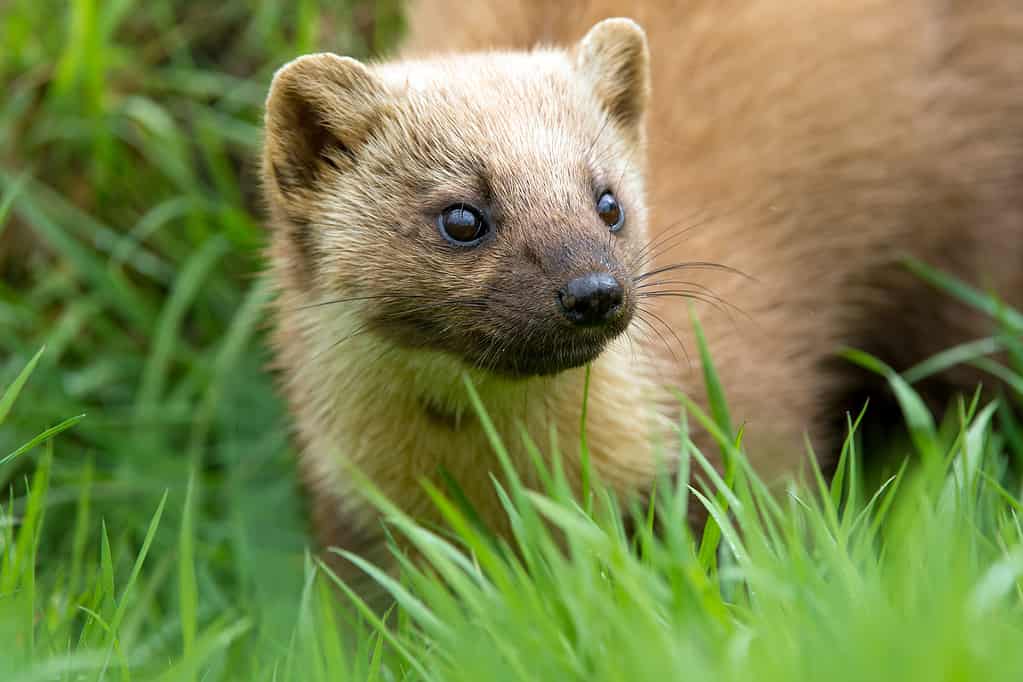
Cute and sweet-looking pine martens are a woodland species and part of the
Mustelidaefamily, including weasels.
©davemhuntphotography/Shutterstock.com
Pine martens are rare in England, but their brutal and aggressive nature is legendary.
Cute and sweet-looking pine martens are a woodland species and part of the Mustelidae family, including weasels. They have rounded ears, long bodies, and short legs. Adults weigh around 4.4 lbs, and large individuals reach 27 inches long. Warm brown fur covers their athletic bodies with a yellow bib and a long bushy tail for balance.
Pine martens are gymnasts of the woodland, even capable of grabbing gray squirrels. Although they tend to hunt rabbits and voles at night, they have been observed chasing squirrels and birds in daylight hours. Stealthy, sneaky, and armed with razor-sharp teeth, pine martens also rob nests of eggs and chicks.
Mainly located in neighboring Scotland, a few pine marten pockets exist in northern England’s pine forests, hence the name “pine” marten.
Summary of The 10 Most Aggressive Animals in England
| Number | Animal | Reasons To Avoid |
|---|---|---|
| 1 | Notch Horn Cleg Horsefly | Spread parasites and disease |
| 2 | Pike | Sharp teeth |
| 3 | Wasps and Hornets | Painful stings and allergies |
| 4 | Adder | Potentially lethal venom |
| 5 | Cows | Stampede if provoked |
| 6 | Yellow-Tailed Scorpion | Painful sting |
| 7 | Badger | Sharp teeth and claws |
| 8 | Lesser Weever Fish | Highly painful venom |
| 9 | Wild Boar | Charging attack and tusks |
| 10 | Pine Marten | Razor-sharp teeth |
The photo featured at the top of this post is © Beata Farkas/Shutterstock.com
Thank you for reading! Have some feedback for us? Contact the AZ Animals editorial team.






